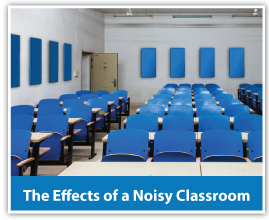The Effects of a Noisy Classroom
- Mar 2, 2017
A noisy classroom environment can limit the academic success of today’s students. Children are not as skilled as adults at staying focused when distractions of any kind ensure – especially sound distractions.
Children with normal hearing can miss as much as 1/3 of the words in a teacher’s message when they are listening in an environment with poor acoustics, according to ClassroomHearing.org.1 An even greater percentage of the teacher’s message is lost when a child already suffers from hearing difficulties and loss.
To remedy a noisy, distracting classroom, effective sound-absorbing acoustic treatments can benefit all children and promote a thriving learning environment for both student and teacher.
Why do classrooms have poor acoustics?
The acoustical problems found inside classrooms happen because of the hard, reflective surfaces and problematic background noise. Classrooms use hard surfaces, like desks and chalk boards, because they are easy to clean and care for. These hard surfaces cause excessive reverberations which can muffle a teacher’s speech, preventing children from clearly comprehending a teacher’s message.
Background noise can also be distracting in the classroom. Noise traveling through doors and windows, either from the street or neighboring classrooms, can be very distracting for young students. In addition the outside noise, HVAC systems and other service elements within the classroom can create more unwanted noise.
Both students and teachers suffer in classroom environments with excessive noise and reverberation. Teachers are forced to speak louder in these environments to ensure that the noise is not interfering with their students’ learning skills. Teachers suffer from voice fatigue and children suffer from an unproductive learning environment.
Sound Solutions for Classrooms
Classroom noise does not have to be something schools simply deal with. There are solutions, both big and small, that administrators can implement to reduce problematic classroom noise. Noise from reverberation is usually easy to fix; simply adding soft materials – like blankets and curtains – to the walls and ceilings will make a significant difference. For a reliable and effective acoustic solution, NRC (Noise Reduction Coefficient) rated products, like Audimute’s acoustic panels, acoustic tiles, and acoustic clouds and baffles will provide consistent sound absorption in the classroom.
Doors and windows can either be replaced entirely or sealed off with a product like Audimute’s door seal kit. Sound travels through the air gaps that surround the doors and windows. To check for these gaps turn off the lights in the hallways and leave the classroom lights on, the gaps will be then be apparent.
Treating the noise from an HVAC system is slightly more problematic. HVAC units can either be enclosed or replaced entirely with a quieter system. The goal is to have an HVAC system that produces an optimum noise level, which is typically 35 dBA in a classroom.
Classroom noise can inhibit students’ academic success and create unnecessary stress for teachers. If you are an administrator dealing with classroom noise, we can help. Give our sound solution experts a call at 866-505-MUTE, or check our resource center for classroom acoustics for additional noise reduction tips.


